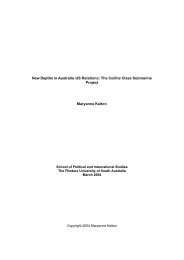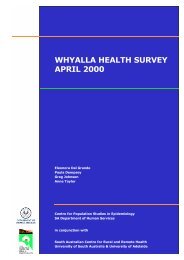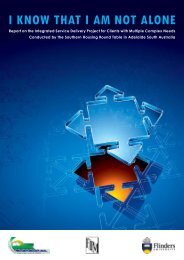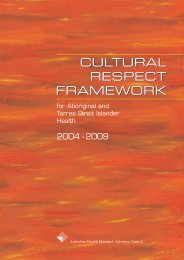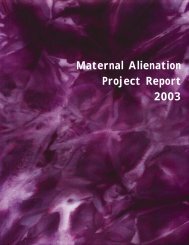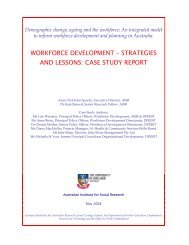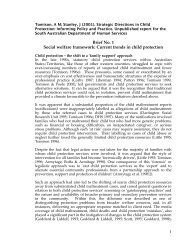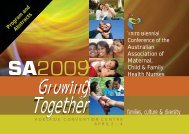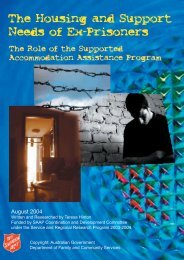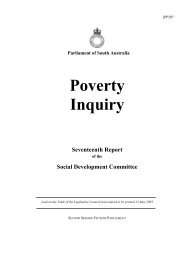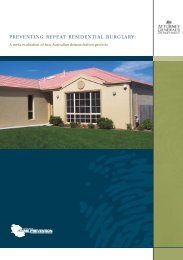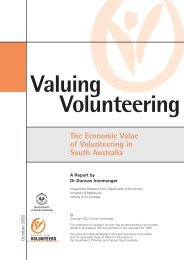Brief No. 2 Social welfare framework - Australian Institute of Family ...
Brief No. 2 Social welfare framework - Australian Institute of Family ...
Brief No. 2 Social welfare framework - Australian Institute of Family ...
You also want an ePaper? Increase the reach of your titles
YUMPU automatically turns print PDFs into web optimized ePapers that Google loves.
Behrman (1998)<br />
This edition <strong>of</strong> The Future <strong>of</strong> Children provides an overview <strong>of</strong> the status <strong>of</strong> child<br />
protection in the United States. Articles describe the historical and future role <strong>of</strong><br />
public child protective services and review recent research about the prevalence<br />
and effects <strong>of</strong> child maltreatment. Trends in family-centred services, foster family<br />
care and kinship care, and <strong>welfare</strong> reform are analysed. The volume also includes<br />
essays that present new paradigms for service delivery, as well as<br />
recommendations for improving child protection. (Abstract from NISC and<br />
BiblioLine)<br />
Besharov et al.<br />
This article contains the recommendations <strong>of</strong> four child protection experts to<br />
improve the child protection system in the United States. The first commentary<br />
focuses on reforms needed in the reporting and decision making process. States are<br />
advised to make child abuse reporting laws more specific and to establish<br />
screening procedures. Reporting accuracy can also be improved by educating the<br />
public and mandated reporters about when reports should be made. Agencies<br />
should take a more realistic approach to families affected by drug addiction, and<br />
acknowledge the widespread effects <strong>of</strong> addiction.<br />
Long-term counselling and supervision are necessary to ensure that a child who<br />
remains at home is not being abused. The second commentary addresses the need<br />
for more effective management <strong>of</strong> child <strong>welfare</strong> services. It argues that single<br />
operating principles, such as family preservation and child protection, are not<br />
extensive enough to make decisions about the complex problems <strong>of</strong> families.<br />
Litigation can be effective to achieve collaboration between child <strong>welfare</strong><br />
administration and community members to improve procedures. The third<br />
commentary examines the organizational structure <strong>of</strong> child protective services.<br />
Parent- pr<strong>of</strong>essional relationships and the politics <strong>of</strong> child <strong>welfare</strong> are specifically<br />
discussed. Emphasis is placed on the conflicts caused by the dual role <strong>of</strong> child<br />
protective agencies to help and also coerce parents. The commentary recommends<br />
that the investigative and foster care functions <strong>of</strong> child protective services be<br />
separated from the prevention and support functions. The final commentary<br />
advocates for community-based partnerships for the prevention and treatment <strong>of</strong><br />
child abuse. These partnerships should increase the focus on prevention, with<br />
support services for all families and early intervention services to reduce the<br />
recurrence <strong>of</strong> abuse. (Abstract from NISC and BiblioLine)<br />
Siegel et al. (1998)<br />
This impact evaluation summarises the findings <strong>of</strong> the <strong>Family</strong> Assessment and<br />
Response Demonstration implemented in Missouri following a mandate in the<br />
state legislature in 1994. The bill required the Department <strong>of</strong> <strong>Social</strong> Services to test<br />
a supportive, non-accusatory intervention to child abuse reports which were<br />
screened and determined to be less threatening. The family assessment response<br />
<strong>of</strong>fered needed services without the trauma, stigma, or delay <strong>of</strong> the investigative<br />
process, and involved the family in a collaborative response to problems and<br />
needs. The demonstration was piloted in 14 small and medium-sized counties<br />
across Missouri. The comparison area included 14 similar counties.<br />
40



